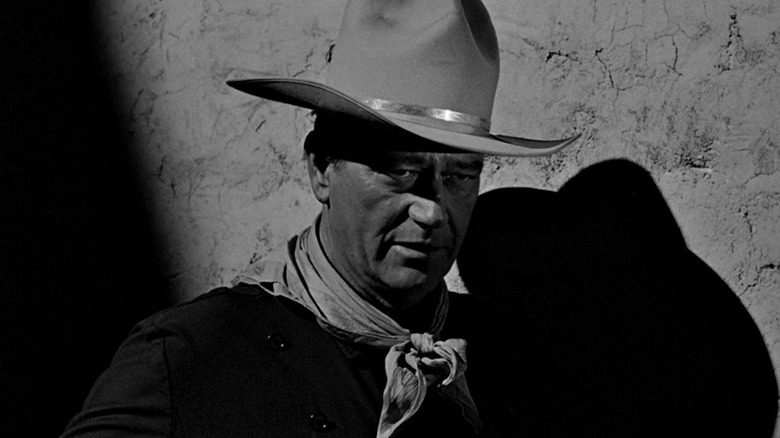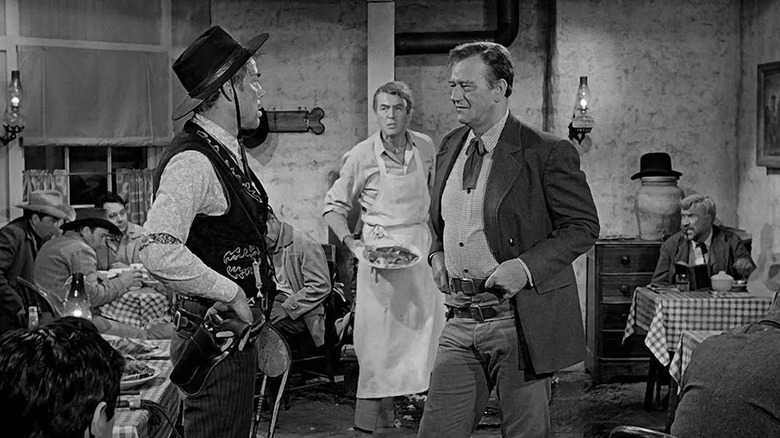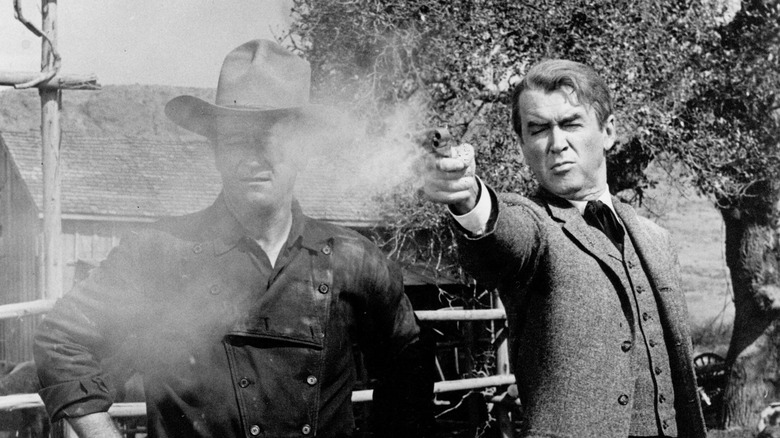John Wayne's Best Western, According To IMDb
You don't need us to tell you that John Wayne was one of the best Western movie actors of all time, but what was his finest Western film? There are plenty of great picks in a career that spanned five decades, both with his regular and most famous collaborator John Ford and with other directors ("Rio Bravo," "True Grit," etc). Two landmark films with Ford often dominate the conversation: Wayne's star-making turn in "Stagecoach," and his unusually dark odyssey in "The Searchers." Both are brilliant shout-outs, but if you pay any attention to IMDb rankings, the director and star went one better with "The Man Who Shot Liberty Valance."
Released in 1962, John Ford's absorbing drama explores the clash between the romanticized myth-making of the Old West and the American frontier's hard-won transition to democratic law and order. That might sound like a bit of a snooze if you're expecting classic matinee-style shootouts and horse action, but Ford and Wayne deliver on those counts, too. "Liberty Valance" is a grown-up Western that is also a cracking piece of entertainment, giving us the first onscreen meeting between Hollywood legends Wayne and James Stewart; an engaging love triangle; a cast of colorful supporting characters; and Lee Marvin as the title character, surely one of the meanest black hats to ever stalk through a saloon.
"The Man Who Shot Liberty Valance" occupies an important place in Western movie history, serving as a curtain call and the passing of the torch. It was Ford's final film in the genre with the Duke, providing John Wayne one of his best roles, and Ford himself was approaching the end of his career as a Western director. After doing arguably more than any other filmmaker to chronicle the American West, he was an influential auteur who was also beginning to reckon with his legacy; two years later, his last Western, "Cheyenne Autumn," would effectively serve as an apology for how he had portrayed indigenous Americans in the past. Meanwhile, "Liberty Valance" helped bridge the gap between the early revisionist Westerns of the 1950s and the more gritty and violent likes of Sergio Leone's "Once Upon a Time in the West" and Sam Peckinpah's "The Wild Bunch." Let's take a closer look at what makes it so memorable, and why it's Wayne's highest-rated Western on IMDb.
What is The Man Who Shot Liberty Valance all about?
"The Man Who Shot Liberty Valance," which wasn't exactly the easiest movie to make, opens with Senator Ransom Stoddard (James Stewart) returning to the pleasant frontier town of Shinbone with his wife Hallie (Vera Miles) to attend the funeral of a friend, Tom Doniphon (John Wayne). A local newspaper reporter is dispatched to get the scoop on the connection between an important politician and an old cowboy. Reluctantly, Stoddard tells the whole story, flashing us back to 25 years earlier when he was an idealistic young lawyer seeking adventure in the Old West.
Arriving in the then-unincorporated and lawless territory, Stoddard's stagecoach is held up by a gang of bandits led by Liberty Valance (Lee Marvin). Stoddard is robbed and beaten before he is found by Doniphon and taken to town. There, he is nursed by Hallie and earns his keep by helping out in the kitchen of a chophouse. He soon learns the state of play in Shinbone: Valance and his two buddies (played by Lee Van Cleef and Strother Martin) terrorize the locals because lily-livered marshal Link Appleyard (Andy Devine) is too scared to stand up to them.
Stoddard is determined to bring the outlaws to justice despite Doniphon's warning that the only way to settle things in those parts is by carrying a six-shooter and being prepared to use it. Stoddard hates violence, however, and establishes his own law practice. He also runs a class to help Hallie and the other illiterate townsfolk receive a basic education. He's a firm believer that learning is the basis of law and order and sets out to gain statehood for the territory. The local cattle ranchers like things just fine the way they are, however, and hire Valance and his gang to intimidate voters. This sets up a showdown between the lawyer and the seasoned gunfighter — but Doniphon still has plenty to say in the matter, despite having romantic reasons for wanting Stoddard out of the picture.
Few Westerns have portrayed the Old West's journey from lawlessness to democracy as well as "The Man Who Shot Liberty Valance," and John Ford strikes an intriguing balance between frontier nostalgia and championing modernity. The casting of two huge stars like Wayne and Stewart certainly helps, with Wayne's memorable drawling cowboy representing the macho old days and Stewart, upstanding but emasculated for much of the movie, representing the way forward.
The complex themes of The Man Who Shot Liberty Valance
I generally try to avoid talking about politics when writing about movies, but it is almost impossible to discuss "The Man Who Shot Liberty Valance" in any other way –- indeed, it has been described by The New Yorker as "the greatest American political movie." As objectively as I can put it, the film tells us this: Democracy, law, education, equality, and freedom of speech are Good Things and the only way for civilized society to thrive. Beating people up, individual greed, terrorizing voters, and violently suppressing the free press are Bad Things.
Stoddard represents the good and Liberty Valance represents the bad, while Doniphon floats somewhere in the middle — he knows Stoddard's crusade is best for the territory, but he still clings to the old ways of frontier individuality and justice. There are some wrinkles, however. To achieve progress for the town, Stoddard must resort to the gun violence he despises and his eventual victory is branded by a reputation more befitting a Wild West gunslinger. By the end, he has achieved a great deal as a senator, but he is still remembered as the man who shot Liberty Valance. The old ways die hard, and, as the newspaper man famously tells him: "When the legend becomes fact, print the legend."
In contrast, Tom Doniphon's arc is a bittersweet way for John Wayne to bow out in his last Western with Ford. He's a two-fisted cowboy who isn't afraid to start shooting if necessary. He would certainly be more comfortable with owning the legend of killing Valance, but he gives up that honor for the town's benefit. He dies alone in anonymity, a sad end for a heroic figure.
"The Man Who Shot Liberty Valance" is a political film of town meetings, stump speeches, and elections, but it's also a Western thriller with tense stand-offs and a suspenseful finale showdown. There are complex themes running throughout, and John Ford presents those ideas without it ever feeling like he's hitting you over the head with them. This highlights Ford's elegance as a filmmaker; for all his association with sweeping vistas and action, he was at his best delivering story and character beats without drawing too much attention to himself. IMDb voters may be right on this one: "The Man Who Shot Liberty Valance" stands up there with John Wayne's very best Westerns.


